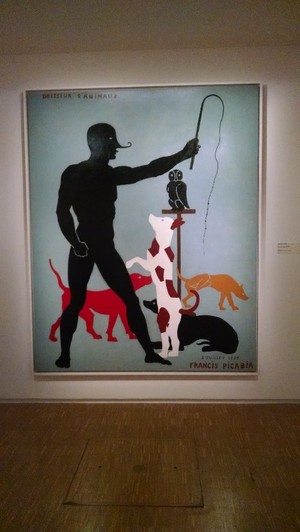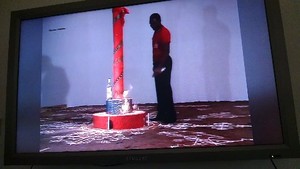Centre Pompidou – Always an Adventure

- SUBSCRIBE
- ALREADY SUBSCRIBED?
BECOME A BONJOUR PARIS MEMBER
Gain full access to our collection of over 5,000 articles and bring the City of Light into your life. Just 60 USD per year.
Find out why you should become a member here.
Sign in
Fill in your credentials below.
 One day during my recent visit to Paris I decided to stroll past the iconic Notre Dame de Paris cathedral and head north across the Pont D’Arcole to the rive droite where less than 10 minutes later, walking up rue de Renard, I marveled once again at what to me is a combination of ugliness and strange beauty – the multi leveled and surrealistic building known as the Centre Pompidou – an edifice of glass and metal and strange white and blue tubes and pipes and foghorn like protrusions designed in the 1970s by Renzo Piano and Richard Rogers (previously unknown architects who beat out the other 649 contest entrants wanting to design the structure).
One day during my recent visit to Paris I decided to stroll past the iconic Notre Dame de Paris cathedral and head north across the Pont D’Arcole to the rive droite where less than 10 minutes later, walking up rue de Renard, I marveled once again at what to me is a combination of ugliness and strange beauty – the multi leveled and surrealistic building known as the Centre Pompidou – an edifice of glass and metal and strange white and blue tubes and pipes and foghorn like protrusions designed in the 1970s by Renzo Piano and Richard Rogers (previously unknown architects who beat out the other 649 contest entrants wanting to design the structure).
The Pompidou is set at the far end of a large plaza with several levels, just across from the 16th Century Gothic church of St. Merri and the Stravinski Fountain with its bright colored sculptures depicting Stravinski’s rites of Spring. An interesting juxtaposition of the historic (St. Merrie who died in year 700 is buried at his namesake church) and the ultra contemporary.
The Centre Pompidou always seems to me to have been plunked down in the midst of the surrounding centuries old typical Paris buildings by someone with a droll and off kilter sense of humor. Parisians were not entirely happy when it went up.
Nevertheless, I find it a fun and exciting place to visit for a number of reasons, not just the strangeness of the structure and the people-watching benefits of the eccentric and diverse the folks who visit the place.
 I love to ride the escalators, which from the street appear to join together as one undulating snake whose metallic body and red belly slithers up the glass side of the building. You are transported up and up along the building’s glass wall as higher and wider views of Paris appear as you climb, until finally you reach the top floor where you can eat or just have a drink in the restaurant with its panoramic views of the City. This is the restaurant where the older but sexy Thierry Hermite seduced a young Kate Hudson in the 2003 film Le Divorce.
I love to ride the escalators, which from the street appear to join together as one undulating snake whose metallic body and red belly slithers up the glass side of the building. You are transported up and up along the building’s glass wall as higher and wider views of Paris appear as you climb, until finally you reach the top floor where you can eat or just have a drink in the restaurant with its panoramic views of the City. This is the restaurant where the older but sexy Thierry Hermite seduced a young Kate Hudson in the 2003 film Le Divorce.
 Despite my habitual leaning towards the more classic French artists such as Monet, Manet, Gaugin and Van Gogh, I have often been tickled or awed, and sometimes confused or disturbed, by one or another of the Pompidou’s more than 50,000 pieces of artwork – which include paintings, sculptures, photographs, and audio /visual interactive works – representing all of the modern movements such as dada, surrealism, fauvism, cubism and expressionism and artists like Picasso, Miro and Man Ray.
Despite my habitual leaning towards the more classic French artists such as Monet, Manet, Gaugin and Van Gogh, I have often been tickled or awed, and sometimes confused or disturbed, by one or another of the Pompidou’s more than 50,000 pieces of artwork – which include paintings, sculptures, photographs, and audio /visual interactive works – representing all of the modern movements such as dada, surrealism, fauvism, cubism and expressionism and artists like Picasso, Miro and Man Ray.
Finally, I love that the curators often surprise visitors by putting together special exhibits about artists, movements or times that are not quite so common or familiar.
This visit was no exception.
Two intriguing exhibits that I saw in July will close on September 15 and therefore must be visited shortly. They are:
 Magicians de la terre (Magicians of the Earth) which revisits the 1989 Pompidou exhibition of the same name (considered groundbreaking at the time in its recognition of the forthcoming globalization of contemporary art), and highlights contemporary artists from the non western world through archives, photos, a contemporary mural, and excitingly – videos of many of the artists both creating and talking about their works. During my visit, I watched in rapt attention and listened with headphones as, for example, an Australian aborigine artist made circles and lines of color by carefully painting each line with a sticky substance and then pushing some kind of bulky material onto the substance; as a Navajo artist carefully created a large and complex sand painting with amazing concentration and control as he dropped the sand from his fingers while explaining that the work was similar but not identical to the work he often does for sacred healing ceremonies– which was too sacred to show in public; as the Yugoslavan Marina Abramovic placed seven quartz pylons on a wall representing the head, heart and sex level in a seemingly random order and explained that you could stand and let the energy pass through; etc..
Magicians de la terre (Magicians of the Earth) which revisits the 1989 Pompidou exhibition of the same name (considered groundbreaking at the time in its recognition of the forthcoming globalization of contemporary art), and highlights contemporary artists from the non western world through archives, photos, a contemporary mural, and excitingly – videos of many of the artists both creating and talking about their works. During my visit, I watched in rapt attention and listened with headphones as, for example, an Australian aborigine artist made circles and lines of color by carefully painting each line with a sticky substance and then pushing some kind of bulky material onto the substance; as a Navajo artist carefully created a large and complex sand painting with amazing concentration and control as he dropped the sand from his fingers while explaining that the work was similar but not identical to the work he often does for sacred healing ceremonies– which was too sacred to show in public; as the Yugoslavan Marina Abramovic placed seven quartz pylons on a wall representing the head, heart and sex level in a seemingly random order and explained that you could stand and let the energy pass through; etc..
 Man Ray, Picabia and the Review “Litterature” (1922-1924) – an exhibit that debuts for the very first time the 26 original covers of this publication that were designed by Francis Picabia and were thought lost until discovered in an envelope in recent years. Before that, only the printed covers existed. The journal apparently is said to cover the overlapping periods when the dada and surrealist movements lived, and the exhibit also includes a number of Man Ray photographs – some of which have become iconographic in the world of photography; along with pages from the journal with cartoons, poems, articles etc. I was fascinated to walk my way through this early era by reading the displayed pages, perusing the photos and artworks, and picturing those exciting days when Picaba, Man Ray, Andre Breton and others broke new ground in the art and literary world.
Man Ray, Picabia and the Review “Litterature” (1922-1924) – an exhibit that debuts for the very first time the 26 original covers of this publication that were designed by Francis Picabia and were thought lost until discovered in an envelope in recent years. Before that, only the printed covers existed. The journal apparently is said to cover the overlapping periods when the dada and surrealist movements lived, and the exhibit also includes a number of Man Ray photographs – some of which have become iconographic in the world of photography; along with pages from the journal with cartoons, poems, articles etc. I was fascinated to walk my way through this early era by reading the displayed pages, perusing the photos and artworks, and picturing those exciting days when Picaba, Man Ray, Andre Breton and others broke new ground in the art and literary world.
No Paris visitor should miss the experience that is the Centre Pompidou – and if you can, plan on visiting before the 15th of September to see these exhibits before they leave.
Centre Pompidou, Place George Pompidou, Paris 4e, tel: 33-1-44-78-12-33; open 11:00 to 9:00 every day but Tuesday (closed Tuesday)
More in centre pompidou, Museum, Paris art museums, Paris museums


